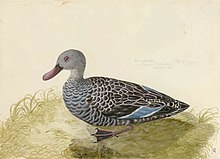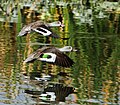| Cape teal | |
|---|---|

| |
| Conservation status | |
 Least Concern (IUCN 3.1) | |
| Scientific classification | |
| Domain: | Eukaryota |
| Kingdom: | Animalia |
| Phylum: | Chordata |
| Class: | Aves |
| Order: | Anseriformes |
| Family: | Anatidae |
| Genus: | Anas |
| Species: | A. capensis |
| Binomial name | |
| Anas capensis Gmelin, 1789 | |
The Cape teal (Anas capensis) also Cape wigeon or Cape widgeon is a 44–46 cm long dabbling duck of open wetlands in sub-Saharan Africa.
Taxonomy

The Cape teal was formally described in 1789 by the German naturalist Johann Friedrich Gmelin in his revised and expanded edition of Carl Linnaeus's Systema Naturae. He placed it with all the ducks, geese and swans in the genus Anas and coined the binomial name Anas capensis. Gmelin based his description on the "Cape widgeon" that had been described in 1785 by the English ornithologist John Latham in his A General Synopsis of Birds. The naturalist Joseph Banks had provided Latham with a water-colour drawing of the teal by Georg Forster who had accompanied James Cook on his second voyage to the Pacific Ocean. His picture was drawn in 1773 at the Cape of Good Hope. This picture is now the holotype for the species and is held by the Natural History Museum in London. The genus name Anas is the Latin word for a duck. The specific epithet capensis indicates the Cape of Good Hope. The species is monotypic: no subspecies are recognised.
Description
Like many southern ducks, the sexes are similar. It is very pale and mainly grey, with a browner back and pink on the bill (young birds lack the pink). This is a generally quiet species, except during mating displays. The breeding male has a clear whistle, whereas the female has a feeble "quack". The Cape teal cannot be confused with any other duck in its range.
This species is essentially non-migratory, although it moves opportunistically with the rains. It is a thinly distributed but widespread duck, rarely seen in large groups except the moulting flocks, which may number up to 2000.
The Cape teal feeds on aquatic plants and small creatures (invertebrates, crustaceans and amphibians) obtained by dabbling. The nest is on the ground under vegetation and near water.
The Cape teal is one of the species to which the Agreement on the Conservation of African-Eurasian Migratory Waterbirds (AEWA) applies.
Gallery
-
 Lake Nakuru, Kenya
Lake Nakuru, Kenya
-
 Serengeti NP
Serengeti NP
-
 Austin Roberts sanctuary, South Africa
Austin Roberts sanctuary, South Africa
-
 Darville, Pietermaritzburg, South Africa
Darville, Pietermaritzburg, South Africa
-
 Darville, Pietermaritzburg, South Africa
Darville, Pietermaritzburg, South Africa
-
 Darville, Pietermaritzburg, South Africa
Darville, Pietermaritzburg, South Africa
-
 Darville, Pietermaritzburg, South Africa
Darville, Pietermaritzburg, South Africa
-
 Darville, Pietermaritzburg, South Africa
Darville, Pietermaritzburg, South Africa
-
 Darville, Pietermaritzburg, South Africa
Darville, Pietermaritzburg, South Africa
-
 Darville, Pietermaritzburg, South Africa
Darville, Pietermaritzburg, South Africa
References
- BirdLife International (2016). "Anas capensis". IUCN Red List of Threatened Species. 2016: e.T22680145A92846056. doi:10.2305/IUCN.UK.2016-3.RLTS.T22680145A92846056.en. Retrieved 12 November 2021.
- Gmelin, Johann Friedrich (1789). Systema naturae per regna tria naturae : secundum classes, ordines, genera, species, cum characteribus, differentiis, synonymis, locis (in Latin). Vol. 1, Part 2 (13th ed.). Lipsiae : Georg. Emanuel. Beer. p. 527.
- Latham, John (1785). A General Synopsis of Birds. Vol. 3, Part 2. London: Printed for Leigh and Sotheby. p. 519, no. 64.
- Mayr, Ernst; Cottrell, G. William, eds. (1979). Check-List of Birds of the World. Vol. 1 (2nd ed.). Cambridge, Massachusetts: Museum of Comparative Zoology. p. 466.
- Lysaght, Averil (1959). "Some eighteenth century bird paintings in the library of Sir Joseph Banks (1743-1820)". Bulletin of the British Museum (Natural History), Historical Series. 1 (6): 251-371 . doi:10.5962/p.92313.
- Jobling, James A. (2010). The Helm Dictionary of Scientific Bird Names. London: Christopher Helm. pp. 46, 89. ISBN 978-1-4081-2501-4.
- Gill, Frank; Donsker, David; Rasmussen, Pamela, eds. (January 2022). "Screamers, ducks, geese & swans". IOC World Bird List Version 12.1. International Ornithologists' Union. Retrieved 4 July 2022.
- Hockey, P.A.R., Dean, W.R.J., Ryan, P.G. (Eds). 2005. Roberts – Birds of Southern Africa, VIIth ed. The trustees of the John Voelcker bird book fund, Cape Town.